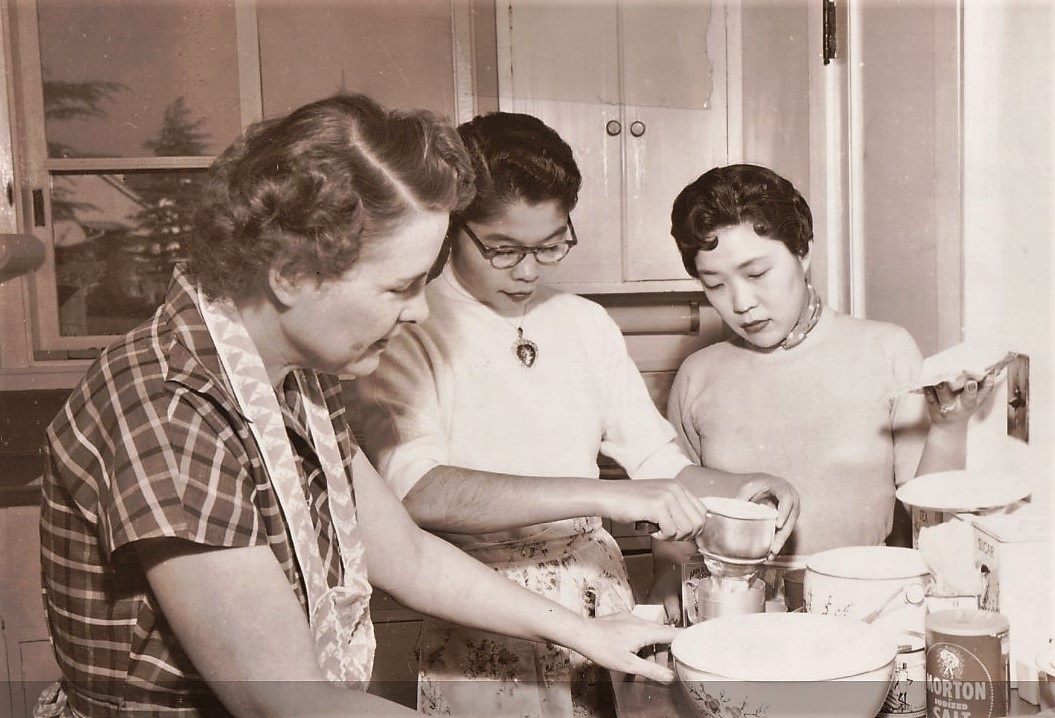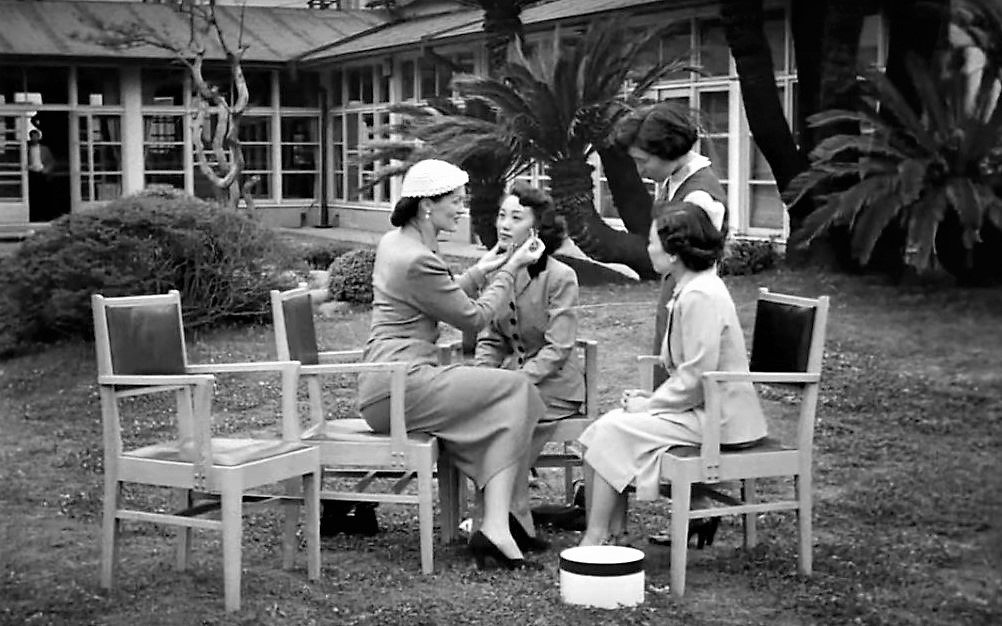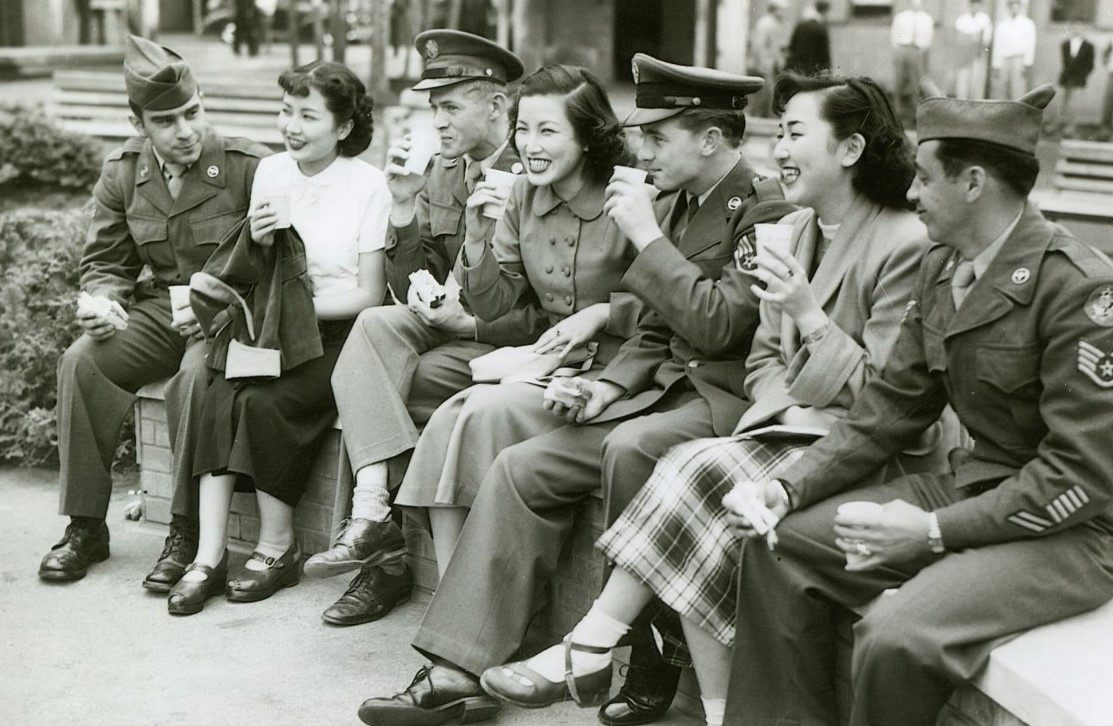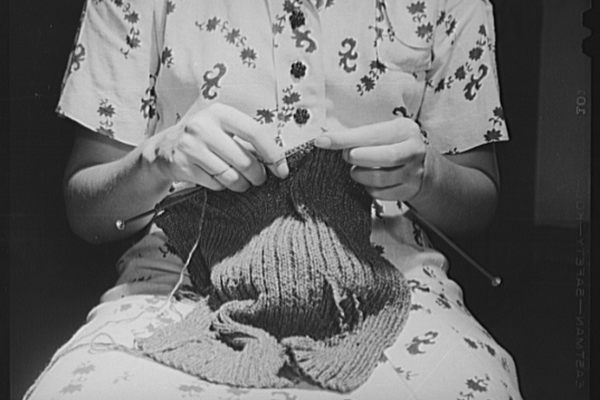The Curious Curriculum of the 1950s Red Cross ‘Bride Schools’
How Japanese women who married G.I.s got taught to be U.S. housewives.

In the 1950s, Japanese women seeking a new life in America had to learn about more than just visa requirements. They also had to learn how to cook hamburgers, entertain neighbors, and confidently walk in high heels. Eyeliner application was, apparently, a vital skill.
These immigrants weren’t just any women. They were the “war brides” of American G.I.s, and some of them learned these lessons at the American Red Cross, which ran schools designed to prepare them for domestic life in the United States.
The American Red Cross Bride Schools sprang up in response to the wave of marriages between American soldiers and Japanese citizens following World War II. Thousands of G.I.s were stationed in Japan during the postwar Allied occupation, which led to several romances with local women. Although the statistics vary, scholars estimate somewhere between 30,000 and 50,000 such marriages took place through the 1950s.
Getting hitched was a headache, considering the stack of documents any Japanese woman had to provide to wed an American soldier. The complicated process took some couples over a year to complete—and it was especially hard on the women. Military officials thoroughly investigated them and their families for any trace of “Communism, venereal diseases, tuberculosis, or anything that would label her as undesirable.” The husband merely needed to prove he was single, a U.S. citizen, and willing to provide financial support.
But the paperwork wasn’t the only problem. Most war brides had little to no concept of what the United States was like. What they did know came from movies and whatever their husbands told them. So the American Red Cross offered lessons on what women could really expect in the U.S. These “bride schools” opened in cities like Tokyo, Sendai, and Yokohama beginning in 1951.

The instructors were usually American wives of stationed military men. Their lessons covered cooking, baby care, etiquette, and everything in between—but despite the educational intentions, the schools took on an unmistakably patronizing tone. “The war bride schools are a great vehicle for neatly encapsulating what we thought of ourselves as Americans at that time and place,” says Lucy Craft, a co-director of the documentary Fall Seven Times, Get Up Eight: The Japanese War Brides. “We won the war and decided that not only had we won the war, but that everything about us was superior to every other civilization, particularly the people who lost the war.”
This superiority complex is evident in a 1952 Saturday Evening Post article reporting on the American Red Cross Bride Schools. The story is full of anecdotes about clueless Japanese students wearing too many slips under their dresses and slapping raw fish right on the stove. “They’ve been children in a nation’s defeat, have gone hungry, have cared for smaller brothers and sisters with the aid of a couple of old kimono sleeves in contrast to the dozens of diapers they’re now given for their own children,” the Post wrote. “Some are quick, some stupid, many average.”
In order to teach their pupils how to be Americans, the instructors had to emphasize the country’s gender roles. And as so many disappointed Rosie the Riveters learned after V.E. Day, America wanted its women back in the home. These Japanese war brides were destined to be housewives, just like their instructors. A typical class might include a tutorial on washing machines, or how to get crisp hospital corners when making the bed. Topics like U.S. history were covered. But cooking was perhaps the biggest part of the curriculum.

“I have a Japanese war bride mother and I grew up with a culinary repertoire of Sloppy Joes, pineapple upside-down cake, spaghetti, and tuna casserole,” says Elena Creef, a professor of women’s and gender studies at Wellesley College. “It’s kind of hysterical. How did my mother learn to master these really basic, slightly awful all-American dishes? Well, she was trained. I guess those lessons were taught very well.”
Classes typically ran for three to six weeks, ending with a graduation ceremony during which students received diplomas. It’s difficult to gauge exactly how many Japanese women completed the American Red Cross Bride School training. In a 1956 article, Ebony reported that “more than 2,000” had enrolled. Japanese scholar Shigeyoshi Yasutomi put the number at 4,500 to 5,000 graduates in 2015. Either figure would constitute just a small fraction of the total number of Japanese war brides. In the absence of the Red Cross classes, they turned to texts (like The American Way of Housekeeping), their husbands, or their eventual American neighbors.
So did these women actually learn from the bride schools, or was it all paternalistic nonsense? Creef insists that, although her mother recalls the classes “with a great deal of laughter, because of the insulting irony,” the American Red Cross was “fulfilling a need.” Craft says the few bride school students she interviewed had positive experiences, while noting that her war bride mother “had zero interest in it.”
The American Red Cross replicated this model across the world to aid all kinds of war brides in their move to the United States—even the ones who already spoke the language. But few crystallized the problems of the postwar globe as clearly as the schools in Japan. The war brides there left believing they’d have more opportunity in America than their economically depressed, spiritually defeated nation could offer. Yet as Craft notes, “Going to a new country just meant that instead of using a broom to clean your house, you got to use a vacuum cleaner. That was your option, not choosing whether to work inside or outside the home.”












Follow us on Twitter to get the latest on the world's hidden wonders.
Like us on Facebook to get the latest on the world's hidden wonders.
Follow us on Twitter Like us on Facebook